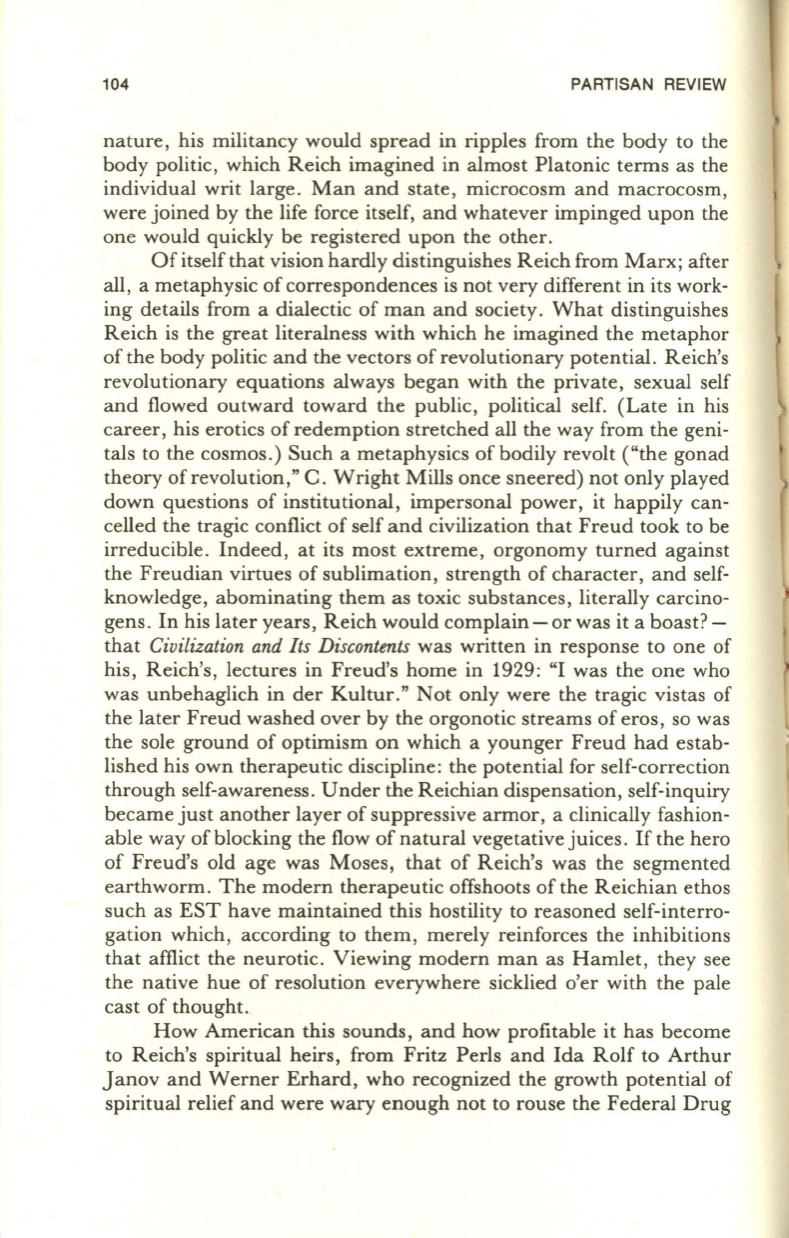
104
PARTISAN REVIEW
nature, his militancy would spread in ripples from the body to the
body politic, which Reich imagined in almost Platonic terms as the
individual writ large. Man and state, microcosm and macrocosm,
were joined by the life force itself, and whatever impinged upon the
one would quickly be registered upon the other.
Of itself that vision hardly distinguishes Reich from Marx; after
all, a metaphysic of correspondences is not very different in its work–
ing details from a dialectic of man and society . What distinguishes
Reich is the great literalness with which he imagined the metaphor
of the body politic and the vectors of revolutionary potential. Reich's
revolutionary equations always began with the private, sexual self
and flowed outward toward the public, political self. (Late in his
career, his erotics ofredemption stretched all the way from the geni–
tals to the cosmos.) Such a metaphysics of bodily revolt ("the gonad
theory of revolution," C. Wright Mills once sneered) not only played
down questions of institutional, impersonal power, it happily can–
celled the tragic conflict of self and civilization that Freud took to be
irreducible. Indeed, at its most extreme, orgonomy turned against
the Freudian virtues of sublimation, strength of character, and self–
knowledge, abominating them as toxic substances, literally carcino–
gens. In his later years, Reich would complain - or was it a boast?–
that
Civilization and Its Discontents
was written in response to one of
his, Reich's, lectures in Freud's home in 1929: "I was the one who
was unbehaglich in der Kultur." Not only were the tragic vistas of
the later Freud washed over by the orgonotic streams of eros, so was
the sole ground of optimism on which a younger Freud had estab–
lished his own therapeutic discipline: the potential for self-correction
through self-awareness . Under the Reichian dispensation, self-inquiry
became just another layer of suppressive armor, a clinically fashion–
able way of blocking the flow of natural vegetative juices.
If
the hero
of Freud's old age was Moses, that of Reich's was the segmented
earthworm. The modern therapeutic offshoots of the Reichian ethos
such as EST have maintained this hostility to reasoned self-interro–
gation which, according to them, merely reinforces the inhibitions
that afflict the neurotic. Viewing modern man as Hamlet, they see
the native hue of resolution everywhere sicklied o'er with the pale
cast of thought.
How American this sounds, and how profitable it has become
to Reich's spiritual heirs, from Fritz Perls and Ida Rolf to Arthur
Janov and Werner Erhard, who recognized the growth potential of
spiritual relief and were wary enough not to rouse the Federal Drug


